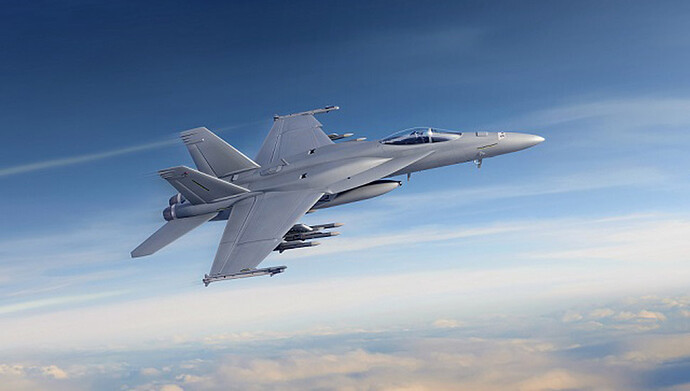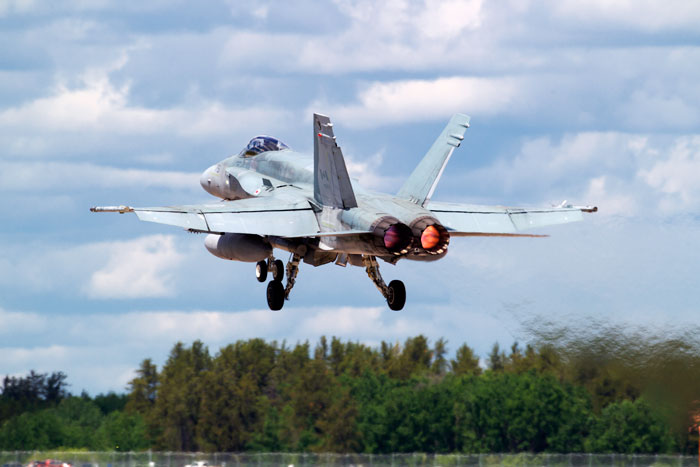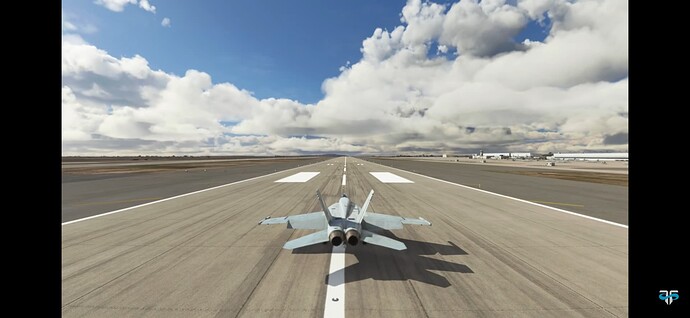The Super Hornet has a living wing, that is to say, the shape of the wing is constantly in motion throughout every regime of flight. Trailing edge flaps, leading edge flaps, stabs, rudders, and ailerons all move in concert to give the pilot the greatest control during particular phases of flight.
This is evident by the use of the flaps switch. The three flap positions are, Auto (Up), Half, and Full. Up auto means that the flight control system (FCS) will dynamically change the wing based on what it thinks the pilot is trying to do. However, when the flaps switch is placed in the half and full positions the FCS switches to landing mode, and all flight control inputs will be interpreted as such. Even though the flaps switch has been placed to half/full, the pilot has only changed the FCS logic, he has not actually commanded the flaps to a fixed position. There are no fixed gains (flaps positions) like there are in typical commercial aircraft. Instead, the computer adjusts the flaps position to mimic a flaps half/full position, while also giving the pilot the most stable platform it can for landing. The logic has its limits though and if the pilot exceeds 14 AoA in a landing mode (flaps half or full), the FCS may accidently depart the jet. This is obviously bad 200 ft above the ground. This switch commands the FCS to make flight control decisions and is the toggle between the tactical, and landing modes of flight.
Rudder Toe-In
The particular effect you are referencing is called rudder toe-in. At slower speeds, particularly during high angles of attack, the stabilators may not provide sufficient nose authority to crisply rotate the nose. The massive wing area of the Rhino tends to block the airflow over the stabs. To remedy this problem the Rhino’s rudders will automatically bias to the inside and create a downward force, which pitches the nose upwards. While the rudder is toed-in, the pilot can still use the rudders to yaw the aircraft. The FCS selectively moves the rudder position to generate the yawing motion, even while retaining the fared-in position.
Take-off and Landing
During takeoff the rudder will remain in the toe-in position for a fixed 10 seconds after it detects weight off the wheels. This prevents the aircraft from accidentally faring the rudders (and losing nose authority) during one of the most critical phases of flight (AoA probe failures will actually cause the rudders to automatically fare, and this problem is removed by a fixed timing.) During the landing portion of flight, the rudders will also be fared in to give the aircraft more nose authority, and this is handled automatically by the FCS once the pilot commands the aircraft into landing mode by placing the flaps switch out of up auto.
Other Functions
While the Rhino does have small speed brakes that extend during full speedbrake deployment, the primary method of increasing drag to rapidly slow the aircraft is through the use of the control surfaces. The FCS will increase the drag by lowering the flaps, toeing-in the rudders, lowing the ailerons, and deflecting the stabs, all while still giving the pilot a stable platform to fly the aircraft–it’s an impressive aircraft.
During high alpha maneuvering, the Rhino will again deflect the rudders to the toed-in position while the flaps switch is in up auto. With the FCS logic in auto, the computers will attempt to retain control of the aircraft during max performance maneuvers, and will automatically schedule the flaps and rudders to compensate for high AoA and slow speed flight. Because the nose is cocked up and the airflow is disrupted over the stabs, the rudders will again create that pitching force that will assist the pilot in maintaining nose authority through any regime of flight.
Emergencies
As stated before, there are times when the rudders may suddenly fare themselves which can have devastating effects during the final portion to land. Rudder failures are serious problems and should be treated as such. Higher landing speeds and extra caution will be used, and the pilot should understand that wave offs may be impossible due to lack of nose authority in close to the ramp.


